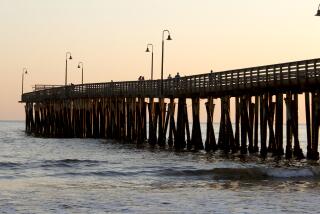In Dana Point, Taking On the Ritz-Carlton : Development: Qintex Group is looking at a smaller, though plusher, resort than plans originally called for, but the city has bigger ideas for its prime coastline site.
- Share via
Local governments hereabouts don’t get many developers asking to build smaller buildings than the law allows.
But it may happen in the beach town of Dana Point. And, in an ironic twist, the town will probably oppose it.
This isn’t just any construction project, either. At stake is one of the choicest pieces of real estate in California, a billion dollars or so and the reputation of a brash Australian financial wizard.
The wiz is Christopher C. Skase, the dapper chairman of Qintex Group, the Australian hotel and television conglomerate.
Qintex recently paid a king’s ransom for the Dana Point land, where Hawaii resort developer Christopher B. Hemmeter had planned a huge, gaudy resort. Now Qintex says it has scrapped Hemmeter’s plan. Instead it plans to build a smaller, plusher resort to compete directly with the Ritz-Carlton just up the road, which caters almost exclusively to the carriage trade.
But the town of Dana Point may not want a smaller hotel, which could mean less revenue from a room tax and more residential development.
And as Qintex’s other big U.S. deal falls apart--the purchase of the MGM/UA movie studio at a price some analysts considered way too high--it raises questions about Qintex’s financial ability to become a big player in the U.S. entertainment and leisure industry. Qintex insists the apparent failure of the studio deal won’t affect the resort.
But both deals are similar in one way: The resort deal is almost as complicated as the intricate MGM/UA deal. And if a fight develops between Dana Point and Qintex over the size of the hotel, for instance, it could take a lot longer--and a lot more money--to get the hotel built.
Dana Point, at first blush, suggests nothing of high finance. It used to be a sleepy little beach town known for funky neighborhoods, cheap apartments and good surfing.
The surfing is still good. But Dana Point is known now as a place where a lot for a single house near the ocean can sell for several million dollars.
Supervisors Blamed
The town began changing in 1971, when a yacht harbor opened. Some of the resulting growth wasn’t planned very well. The town folk blamed the five county supervisors 20 miles or so up the freeway in Santa Ana. Last year they’d had enough: They voted to incorporate and take control.
But developers managed to persuade the county supervisors to approve 1,700 new homes before the incorporation. (This in a town of 28,000.) So no matter where you go in Dana Point these days, you are never far from the skeletal frames of new houses and the drumbeat of hammers.
The biggest change, though, is the hotels. There are two of them perched on the bluffs above the ocean: the marble-laden Ritz-Carlton and the less stuffy Dana Point Resort.
With the hotels and the tourists and the construction and the bustle, the town is beginning to seem less like the funky beach town it once was and more like its trendy neighbors just up the coast: artsy-craftsy Laguna Beach and glitzy Newport Beach with its yachts and socialites.
It had to happen eventually: Dana Point was the closest place to Los Angeles that still had lots of empty land for sale right on the ocean.
Drive south down the coast from Los Angeles County and the first big open space that’s not already spoken for is just behind Dana Point’s Monarch Beach, namely, 232 empty acres on a bluff overlooking the Pacific. It is, says Christopher B. Hemmeter, a man with an eye for choice real estate, “one of the best pieces of land in the United States.”
First on California Coast
Hemmeter should know; he has made a mint picking good spots, most of them in Hawaii, on which to put hotels. This was to be his first on the California coast.
It was 1987 when Hemmeter joined two local developers, David Stein and Barry Brief, to build one of Hemmeter’s elaborate resorts. (Stein-Brief Group owned the land, and Stein-Brief and Hemmeter paid Stein-Brief’s lender just $32 million to obtain the land free and clear less than two years ago.)
The hotel was to be a copy of William Randolph Hearst’s grandiose castle in San Simeon. The old press lord probably would have liked the frills Hemmeter planned: a water ride through a Japanese garden, a theater big enough to stage an opera and an ice-skating rink.
The partners needed $450 million to build it. They hired an investment banker to find an investor who would put in $150 million in return for 50% of the hotel. The group would then borrow the other $300 million, according to David Stein.
The investment banker brought them Skase, and Skase surprised everyone by offering to buy the whole thing.
“They asked what price I’d accept,” Hemmeter says. “I told them our bankers wouldn’t let us turn down $100 million more than what we paid for it. They came back with an offer of $132 million. We couldn’t turn it down.”
Qintex had paid a stiff price, and almost all of it in cash, a source said. On the other hand, it was no longer a junior partner. Now that it had gotten rid of Hemmeter, it could design any sort of hotel it wanted. And it was in a position to go out and find investors to risk their own cash in return for just a minority interest in the hotel.
If Qintex can make its new hotel a going concern, it will look like a pretty smart deal. If the hotel is a bust, however, it could put a serious dent in Qintex’s plans to become a major operator of resorts in the United States.
That kind of gamble is not unusual for Skase, 41, the nattily attired former stockbroker and business reporter. He is regarded by admirers as something of a precocious genius, a man who according to Qintex lore became a millionaire while still in his 20s. Skase took the Brisbane-based company from practically nothing to $2 billion a year in revenues.
Produced “Lonesome Dove”
Besides the MGM deal, Qintex is probably best known in the states for producing “Lonesome Dove,” the hit television miniseries. But it has also built two big Australian resorts, acquired an Australian television network and bought a Hawaiian resort.
Not, however, without detractors. Qintex stock has languished until recent months, when the problems with the MGM/UA deal sent it plummeting from $1.50 Australian to the 40-cent range; even before MGM/UA, the company had a propensity to scare off investors by running up heavy debt. “The stock’s performed dismally,” says Brad Orgill, an analyst for S.G. Warburg & Co. in Melbourne.
It was the film business that first lured Qintex to America. After picking up a small company, Qintex went big time: It outbid another Australian tycoon, Rupert Murdoch, for MGM/UA. That deal was to cost Skase a hefty $1.5 billion. But last week MGM/UA backed out and accused Skase of missing a September deadline for delivering a $50 million letter of credit. Qintex accused MGM/UA of queering the deal by continuing to make exorbitant demands after the deal was closed.
The lesson, of course, is that glamorous stuff like resorts and movie studios don’t come cheap.
But at first it’s hard to see what’s so glamorous about Dana Point. It is, after all, a nice little town. But it’s not Hawaii or Tahiti.
The answer, oddly enough, is back in Hawaii: The place is overrun with resorts. There aren’t many suitable spots left on which to build a new one.
Searching the Globe
So resort developers fan out over the globe looking for likely locations. One of the likeliest is Southern California, since it comes with its own enormous, ready-made market.
After some rocky years, the success of the Ritz-Carlton--which is celebrating its fifth anniversary--showed a resort hotel could work in Orange County. The Ritz-Carlton is one reason everybody with a piece of coastal property in the county is building a hotel these days.
The lesson hasn’t been lost on Qintex, either. In fact, now that Qintex has tossed out Hemmeter’s Hawaiian fantasy, Qintex executives say they want to build the kind of resort they’re more comfortable with, the kind they run in Australia and which they compare--with a little exaggeration, say experts--to the Ritz-Carlton.
There’s just one small problem: The land Qintex bought is approved for two adjacent hotels, an 800-room behemoth and a 300-room building. Together, they would be one of the largest hotels on the California coast.
That’s a perfect size for Hemmeter’s waterfalls, ponds and opera house. But it is too big and impersonal to have the same cachet as the Ritz-Carlton. With only 393 rooms and 850 employees, the Ritz-Carlton boasts better than two employees per room and the sort of service that keeps the Dom Perignon cold and the towels hot for its rich, pampered guests. The hotel is, in fact, Dana Point’s largest employer.
Extremely Expensive
When Skase told The Times in July at the time of the land sale that his hotel would be less than 1,000 rooms, he was apparently thinking about the Ritz-Carlton and this fact of hotel economics: In order to make a profit, a hotel needs to charge $1 in room rates for every $1,000 it costs to build the room. Qintex’s hotel will be extremely expensive since Qintex paid such a princely sum for the land. So the hotel will have to be very posh indeed to justify the steep room rates it will need to charge.
There are other advantages to a smaller hotel, advantages that may also be crucial if the resort is to make money on all that expensive land. A smaller hotel might leave Qintex more room to build condominiums and houses around the resort. Qintex says it is considering this. And well it should: They would be extremely profitable to build. You can charge a lot more for houses when they are near a resort or close to a golf course, and there is a golf course already operating on the property.
Selling high-priced houses could also defray the costs of buying the land and tide the hotel over its first--and probably unprofitable--years. Qintex already builds homes at its two Australian resorts. If you don’t want to use your villa--as Qintex calls condos--year-round, the hotel will rent them to guests for you.
But over at Dana Point’s tiny City Hall--a trailer where city officials wait for their new rented offices to be finished--the notion of more houses and a smaller hotel sets off alarms.
The reason: Fewer hotel rooms mean less revenue from the city’s 8% room tax. The Hemmeter hotel, by some estimates, would have brought in a cool $5 million to $6 million a year. That’s terribly appealing to a town that takes in less than $10 million a year and which--until little less than a year ago--depended on the largess of county government for its public services.
Another worry is traffic. New houses would probably generate as much traffic as a resort hotel, where at least the guests stay put, and it might generate more. Irate residents have killed projects they thought created too much traffic.
Stein and Hemmeter spent months haggling with the county, the state Coastal Commission and now the new city government for approval to build their hotel. Getting a change could take Skase more months--perhaps years--and lots more money, which Qintex says it realized going into the deal.
Because residents don’t want the traffic from new housing, “there’ll be major resistance if Qintex decides to downscale the hotel or put houses on that land,” says City Manager William O. Talley.
Eileen Krause, the town’s new mayor, is a little more conciliatory. She wouldn’t mind a smaller hotel, she says, but not if that means making room for more houses.
Some town folk say they are starting to get nervous because Qintex has yet to announce definite plans for the Hemmeter land and another parcel just down the road. (Qintex says it will have an announcement within 90 days.)
Headlands Property
That other piece of land is 115 acres on the Dana Point headlands a quarter of a mile down the coast, for which Qintex paid another $115 million. The headlands is a stunning piece of property, but “a very emotional one for the town,” says a city planner.
A town landmark, the headlands was empty when 19th-Century novelist Richard Henry Dana first sailed by in 1835 and mentioned it in “Two Years Before the Mast.” (The town later borrowed his name.) Most of the headlands has remained empty since. Whatever goes up there is sure to be unpopular with at least some town folk. A fence across the property is routinely breached by surfers and other locals with a proprietary interest in this stretch of coast.
Chandler-Sherman Corp., the old owner, had persuaded the county to zone the land for quite a few townhouses and two hotels. But as yet nobody holds a permit to actually build anything.
Qintex actually went after this piece of property before the Hemmeter property, but buying both may have been smart: Since the two properties are tied together, any improvements Qintex makes to the Hemmeter property--like the planned upgrading of the golf course there--enhances the value of the houses it builds down the road at the headlands.
What seems likely to happen, Qintex says, is this: The company will ask to build an extremely lavish--if smaller--hotel on the Hemmeter property and build mostly houses and condominiums--and possibly another small hotel--on the headlands, still close enough to the resort for residents to use the golf course, restaurants and other amenities.
But then there’s this last small problem: Where are these new hotels going to find enough guests?
A waterfront hotel is going up in Huntington Beach and--within the next few years--on the Irvine Co. property between Newport Beach and Laguna Beach. Within a few years, there will be thousands of new hotel rooms on a stretch of coast that until five years ago had none. Some experts expect at least a temporary glut.
And some are skeptical that the Orange County coast will attract tourists from all over the world. “As Orange County continues to urbanize, who wants to come to a smoggy and congested part of the country for a vacation?” asks Christopher B. Leinberger of real estate consultants Robert Charles Lesser & Co. The real money to be made in those hotels, then, is likely to be from conventions and business conferences. Resort hotels are so expensive to build these days that most of them can’t rely on tourists to return their owners’ investment: They have to scramble for convention business too.
Even the Ritz-Carlton, which by all accounts has made a roaring success catering to the rich, says it makes a lot of its money from mundane business meetings. And when the Irvine Co.’s first hotel--a 1,100-room Marriott--opens up the coast in 1993, it will have a big advantage over almost everyone else: It will be only minutes from John Wayne Airport, an obvious attraction to people who book conventions.
But Qintex’s hotel may have an advantage too, a little something called rich Japanese investors. Although no announcement has been made yet, the Japanese are likely to be big investors in the resort, sources said. The Japanese can borrow money in Japan at lower interest rates and thus can invest a lot for a rate of return that looks piddling by U.S. standards. That means that while the sums they pay for hotels and golf courses and office buildings seem astronomical and unprofitable from the U.S. point of view, Japanese buyers can still make a decent profit because they borrowed money at such low rates.
And there are cultural differences too, which mean Japanese investors won’t be pressing Qintex for a quick score: They’re often willing to take a small return now in exchange for a big payoff down the road if, for instance, the hotel is sold.
It was the Japanese who bailed Qintex out when it got top-heavy with debt from building its two Australian resorts and buying the Princeville resort in Hawaii. Skase sold 49% of the three resorts to consumer credit company Nippon Shinpan Co. and the trading concern Mitsui and Co. As part of that deal, both got first crack at buying 49% of the Dana Point hotel and, given the enthusiasm of Japanese investors for resorts and golf courses, there is a good chance they will take it.
The Japanese like hotels and resorts because--when inflation’s running high--you don’t have to wait for a lease to expire before you can raise prices. Tokyo Masuiwaya, Japan’s biggest maker of kimonos, bought the nearby Dana Point Resort in July for $104 million from Edward and Thomas Slatkin, who walked away with $40 million more than they paid for the hotel last year.
At the nearby Ritz-Carlton, however--where rooms start at $185 a night and run up to $2,000 for a suite with a study, grand piano and fireplace--the management professes not to be worried by the prospect of competition from Qintex.
“A five-star hotel is not just marble and crystal,” sniffs Henry E. Schielein, the Ritz-Carlton’s general manager.
“They still have to prove they can do it. And I won’t lose sleep over it until I see something happen.”
More to Read
Inside the business of entertainment
The Wide Shot brings you news, analysis and insights on everything from streaming wars to production — and what it all means for the future.
You may occasionally receive promotional content from the Los Angeles Times.










